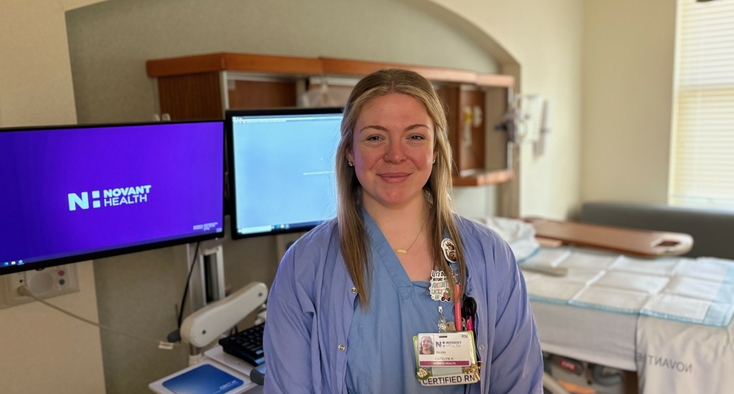If you have an umbilical or ventral hernia and know you need to get it repaired, this article is for you.
Before my planned umbilical hernia repair surgery, which took place in July 2024, I wondered what surgery would feel like, what to plan for in terms of recovery, and whether I’d be happy with the end result. My surgeon gave me general information, but I wanted “the real scoop” from someone who had been through the surgery. So, the information that follows is what I would have wanted to read.
Important caveats: I am not a doctor; just a patient. This article has been medically reviewed by Dr. Thomas Gavigan of Novant Health Carolina Surgical - Randolph in Charlotte, but every person’s medical situation is different, and my experience may be different from yours. Additionally, I had two minimally invasive gynecology procedures done during my surgery (details at the end). Although this didn't add extra incisions to my body or extend my recovery, I am mentioning it for full transparency.
Here's what I'd tell a friend preparing for this surgery, based on my own experiences.
Nationally recognized surgical treatment close to home.
I had hernia surgery and here's what I'd recommend for anyone else considering it
Plan to prehab before your surgery.
I was already active, but two months before my surgery, I made exercise a nonnegotiable daily appointment. That’s because my surgeon talked to me about “prehab” — improving my health before surgery to improve my surgical outcomes. Gavigan describes surgery like a marathon: "The better shape you are in going into a marathon, the better you're going to do.”
He encourages patients to focus on four things during prehab: building muscle, improving their cardiovascular function, controlling their blood sugar (and losing weight if their body mass index is over 30), and building a positive mindset by understanding their surgery and recovery plan.
To get my body ready for the stresses of surgery, I did Peloton rides and a full-body strength training plan, modifying the core work as needed for my hernia. I also ate healthier than usual and went to sleep on time.
Identify your “why.”
Although it is medically necessary to repair most hernias, I still worried I was being selfish to have a planned surgery. I have three young children and hated asking for help caring for them and for myself. I also worried something would go wrong during or after surgery. Did I really need to do this, or could I just put it off … forever?
When these anxieties hit me, I’d remind myself: I deserve a functioning body. And scheduling surgery avoids an emergency hernia repair (no doubt coming at the worst possible time), which would ultimately be much more disruptive to my family.
Plan to rest the day of surgery. But also to walk.
The day of surgery, my mom watched my kids — and my husband watched me. When I reported for surgery at 5 a.m., I didn't know yet if I'd end up staying overnight in the hospital or whether I'd be discharged that day. That's pretty common, Gavigan said, so make sure your support team is prepared to be flexible.
My hardest moment was preparing for anesthesia to hit and deciding to stay on the table instead of calling the whole thing off. I repeated my “why,” prayed, and actively chose to trust my care team.
I woke up in a recovery room, heard everything had gone well, and fell asleep again for a few hours. Later, I was transferred to a hospital room where I slept, ate a Popsicle, and was encouraged to get up and walk a few steps with my husband and a nurse. I didn't feel acute pain; instead, it was a dull ache, kind of like I had been punched. (If you grew up with siblings, you know what I'm talking about.)
Because my surgery had gone well, I was walking, and I didn’t report a lot of pain, they discharged me at 5 p.m. in a wheelchair. My stomach was distended from the procedure, so I went home in pajama pants.
Nausea hit hard on the ride home. I went immediately to a recliner and spent the next few hours trying not to throw up. Eventually, I was able to eat some chicken noodle soup.
My care team had told me, "Walking is your best friend.” So once my stomach stopped churning, I tried to do a few steps every hour that I was awake.
5 tips from my experience the week after hernia surgery
1. Set a timer for meds and have over-the-counter medication and ice packs ready. My care team said “Stay on top of the pain — don't let it get on top of you" and recommended setting alarms to remind me to alternate ibuprofen and acetaminophen every three hours, even at night. That’s good advice, Gavigan said, adding that it's important to take ibuprofen with food.
I received a prescription for pain medication but found that I never needed anything stronger than the over-the-counter medication. When pain was at its worst (usually about 30 to 45 minutes before my next dose was due), I would sit with bendable ice packs on my abdomen and distract myself. There was never a point where I felt unbearable pain.
2. Rest as needed but walk too. I spent the first night and most of days one to three on a recliner. During the day, I got up frequently to walk, even though I was tired and my body felt a little unfamiliar. I set a goal to walk a little longer each time: once around the kitchen island, then twice, then around the whole kitchen. On day three, I walked a lap on the driveway with someone next to me since I still felt a little nervous, and by day six I was walking laps by myself with confidence.

I wore loose pants for a few weeks because I was swollen from surgery — and wearing an abdominal binder, an elastic Velcro compression wrap that Gavigan said is important for postoperative healing in certain cases.
Here is a very flattering photo of what that looks like. You’re welcome.
I wore it all day for six weeks; follow your doctor’s instructions. I wore a camisole underneath so it didn't irritate my skin.
You can shower the same day of surgery if you want. I’d recommend having a person to help you balance as you get in and out and sticking to the basics (it's probably not the time to shave your legs). You’re not allowed to submerge yourself for a few weeks as your incisions heal, so no baths.
4. Think ahead about sleeping. I had four small incisions: one “in” my belly button, and then three in a C-shape on my left abdomen. I felt uncomfortable lying flat on my back, but didn’t want to irritate my incisions; a wedge pillow would have been helpful. Ask your provider how you should get in and out of bed. If you've had a cesarean section, you've already gotten this lesson.
5. Stock your pantry and fridge ahead of time: My surgeon recommended a very high protein diet five days before and after surgery. That's because protein is imperative for good wound healing, especially in hernia repair surgery, Gavigan said. In addition to protein, he recommends that patients drink lots of fluids, eat fiber-rich foods like fruits and vegetables, and avoid sugars.
I had zero energy for cooking and little appetite for the first week. My mom made me chicken noodle soup, salads, hard-boiled eggs, baked salmon and chicken, and fruit smoothies with protein powder, so every bite was nutritious. By the end of week two, my appetite was mostly back to normal.
Gavigan also recommends Miralax or a stool softener to make sure things keep moving along.
Everyone’s recovery timeline will be different after hernia surgery, but here are a few details on mine.
Week 1: I stayed home for six days after surgery. On day seven, I went to my post-surgical check and then an all-day medical appointment for a family member. That was exhausting but necessary, so I rallied.
Week 2: I started walking 15 consecutive minutes each day, challenging myself to build on that time over the coming weeks as I started to feel stronger. I treated walking like I had treated prehab: nonnegotiable. A friend and I had coffee one afternoon. Otherwise, I stayed home and rested.
Week 3: I started driving again and worked part-time at home. If your job is physical, you may need to be out longer, Gavigan said.
Week 4: By this week, I could have returned to an office if I didn't work from home, but be warned: The end-of-the-day exhaustion is real. This week, I also stopped preemptive medication. I used ice packs and Tylenol as needed and tried to pace myself. If I didn't, I paid for it with discomfort and exhaustion.
Week 5 and 6: At the end of week 6, I started physical therapy (it’s not necessary for every patient, but if your surgeon directs you to go, “Then go. It will make your outcomes so much better," Gavigan said). We focused on building my core muscles and retraining my movement patterns now that I could fully engage my core. I did progressive daily “homework” for this over the next few months, including diaphragmatic breathing and movements like cat/cow, bird dogs and bridges.
Throughout recovery, I walked daily and was told to avoid bending, twisting, and lifting anything heavier than a milk jug. I needed help with loading a dishwasher, taking out the trash and doing laundry.
You’ll be down for a while after hernia surgery. But you'll rise again.
About three months after surgery, I felt fully back to myself energy-wise.
Although it required energy, expense and others' help, I am glad I had surgery: I feel better functionally “in" my body, and I’m much happier with how it looks on the outside as well.
I’m not alone: “Almost universally, every patient says I wish I had done this sooner,” Gavigan said. If you have a hernia, here's his advice: “When you're ready, circumstances are correct for surgery, and your health status been optimized for surgery, get it fixed.”
I couldn’t agree more!
Practical considerations for hernia surgery if you have young kids
Pregnancy can be a cause for ventral and umbilical hernias, so I suspect some of you reading may have kids. My hernia was diagnosed around nine months postpartum, but at the time, my primary care provider Dr. Jeffrey Many of Novant Health Lakeside Family Physicians - Denver recommended “watchful waiting” and postponing surgery until my child wasn't so physically dependent on me.
Before surgery, I taught my 3-year-old to get in and out of her car seat alone and retired her highchair. I needed help lifting her in and out of her crib for six weeks for morning, nap time and bedtime.
We explained my surgery and limitations to my kids. The abdominal binder was a good visual reminder.
Although I could interact with my kids from day one, I needed full-time care for them for the first two weeks. Going into the third week, I still felt uncomfortable reacting in an emergency, so I ended up booking help that week too. You will need more help than you are used to.
I have a family history of ovarian cancer and am done growing my family, so during my hernia repair — and using the same incisions — I also had my fallopian tubes removed.
Additionally, a symptomatic complex ovarian cyst was removed upon the recommendation of my OB-GYN, Dr. Michael Sexton of Novant Health Harbor Point OB/GYN - Huntersville. I am very grateful that multiple issues could be addressed in one surgery and recommend talking with your doctor(s) about personalized concerns you may have.













